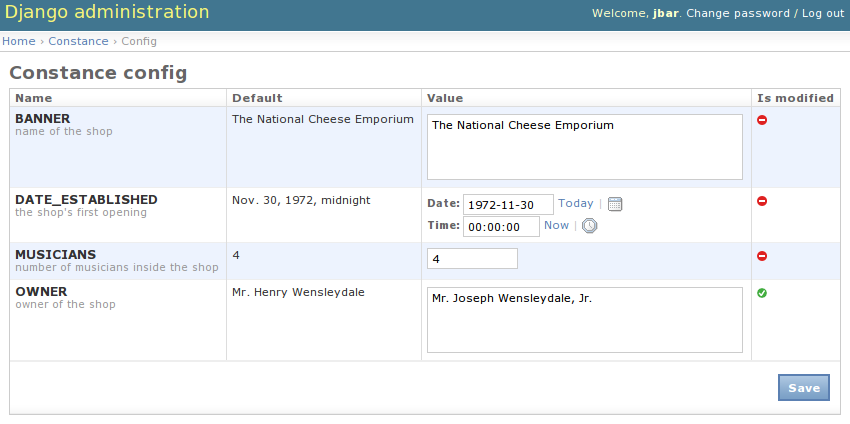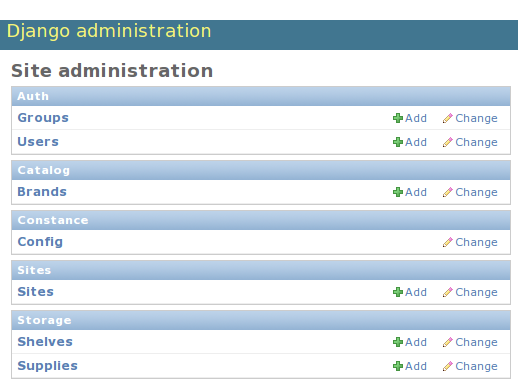Django live settings with pluggable backends, including Redis.
Project description

Fork
This is a fork of the original django-constance project which can be found at:
Main reason for the fork is to have django-constance pip installable with Django 1.4+ compatibility fixes.
Hopefully we can have this fork merged back into the official repository as soon as possible.
Features
Easily migrate your static settings to dynamic settings.
Admin interface to edit the dynamic settings.
Installation
Install from PyPI the backend specific variant of django-constance:
For the (default) Redis backend:
pip install django-constance[redis]
For the database backend:
pip install django-constance[database]
Alternatively – if you’re sure that the dependencies are already installed – you can also run:
pip install django-constance-trbs
Or install the git development version using pip:
pip install -e git+git://github.com/trbs/django-constance-trbs#egg=django-constance-trbs
Configuration
Modify your settings.py. Add 'constance' to your INSTALLED_APPS, and move each key you want to turn dynamic into the CONSTANCE_CONFIG section, like this:
INSTALLED_APPS = (
...
'constance',
)
CONSTANCE_CONFIG = {
'MY_SETTINGS_KEY': {
'default': 42,
'help_text': 'the answer to everything'
},
}
Here, 42 is the default value for the key MY_SETTINGS_KEY if it is not found in the backend. The help text will be shown in the admin.
See the Backends section how to setup the backend.
Backends
Constance ships with a bunch of backends that are used to store the configuration values. By default it uses the Redis backend. To override the default please set the CONSTANCE_BACKEND setting to the appropriate dotted path.
Redis (default)
CONSTANCE_BACKEND = 'constance.backends.redisd.RedisBackend'
The is the default backend and has a couple of options:
CONSTANCE_REDIS_CONNECTION
A dictionary of parameters to pass to the to Redis client, e.g.:
CONSTANCE_REDIS_CONNECTION = { 'host': 'localhost', 'port': 6379, 'db': 0, }Alternatively you can use a URL to do the same:
CONSTANCE_REDIS_CONNECTION = 'redis://username:password@localhost:6379/0'
CONSTANCE_REDIS_CONNECTION_CLASS
An (optional) dotted import path to a connection to use, e.g.:
CONSTANCE_REDIS_CONNECTION_CLASS = 'myproject.myapp.mockup.Connection'
CONSTANCE_REDIS_PREFIX
The (optional) prefix to be used for the key when storing in the Redis database. Defaults to 'constance:'. E.g.:
CONSTANCE_REDIS_PREFIX = 'constance:myproject:'
Database
CONSTANCE_BACKEND = 'constance.backends.database.DatabaseBackend'
If you want to use this backend you also need to add the databse backend to your INSTALLED_APPS setting to make sure the data model is correctly created:
INSTALLED_APPS = (
# other apps
'constance.backends.database',
)
It also uses django-picklefield to store the values in the database, so you need to install this library, too. E.g.:
pip install django-picklefield
Alternatively follow the backend specific installation instructions above.
The database backend has the ability to automatically cache the config values and clear them when saving. You need to set the following setting to enable this feature:
CONSTANCE_DATABASE_CACHE_BACKEND = 'memcached://127.0.0.1:11211/'
Starting in Django 1.3 you can alternatively use the name of an entry of the CACHES setting. E.g.:
CACHES = {
'default': {
'BACKEND': 'django.core.cache.backends.memcached.MemcachedCache',
'LOCATION': '127.0.0.1:11211',
}
}
CONSTANCE_DATABASE_CACHE_BACKEND = 'default'
Just like the Redis backend you can set an optional prefix that is used during database interactions. To keep backward compatibility it defaults to '' (an empty string). To use something else do this:
CONSTANCE_DATABASE_PREFIX = 'constance:myproject:'
Usage
Constance can be used from your Python code and from your Django templates.
Python
Accessing the config variables is as easy as importing the config object and accessing the variables with attribute lookups:
from constance import config # ... if config.MY_SETTINGS_KEY == 42: answer_the_question()Django templates
To access the config object from your template, you can either pass the object to the template context:
from django.shortcuts import render from constance import config def myview(request): return render(request, 'my_template.html', {'config': config})Or you can use the included config context processor.:
TEMPLATE_CONTEXT_PROCESSORS = ( # ... 'constance.context_processors.config', )This will add the config instance to the context of any template rendered with a RequestContext.
Then, in your template you can refer to the config values just as any other variable, e.g.:
<h1>Welcome on {{ config.SITE_NAME }}</h1> {% if config.BETA_LAUNCHED %} Woohoo! Head over <a href="/sekrit/">here</a> to use the beta. {% else %} Sadly we haven't launched yet, click <a href="/newsletter/">here</a> to signup for our newletter. {% endif %}
Editing
Fire up your admin and you should see a new app called Constance with MY_SETTINGS_KEY in the Config pseudo model.
By default changing the settings via the admin is only allowed for super users. But in case you want to use the admin’s ability to implement custom authorization checks, feel free to set the CONSTANCE_SUPERUSER_ONLY setting to False and give the users or user groups access to the constance.change_config permission.
Screenshots

The standard edit screen.

The virtual application Constance among your regular applications.
Changelog
v0.6 (2013/04/12)
Added Python 3 support. Supported versions: 2.6, 2.7, 3.2 and 3.3. For Python 3.x the use of Django > 1.5.x is required.
Fixed a serious issue with ordering in the admin when using the database backend. Thanks, Bouke Haarsma.
Switch to django-discover-runner as test runner to be able to run on Python 3.
Fixed an issue with refering to static files in the admin interface when using Django < 1.4.
v0.5 (2013/03/02)
Fixed compatibility with Django 1.5’s swappable model backends.
Converted the key field of the database backend to use a CharField with uniqueness instead of just TextField.
For South users we provide a migration for that change. First you have to “fake” the initial migration we’ve also added to this release:
django-admin.py migrate database --fake 0001
After that you can run the rest of the migrations:
django-admin.py migrate database
Fixed compatibility with Django>1.4’s way of refering to static files in the admin.
Added ability to add custom authorization checks via the new CONSTANCE_SUPERUSER_ONLY setting.
Added Polish translation. Thanks, Janusz Harkot.
Allow CONSTANCE_REDIS_CONNECTION being an URL instead of a dict.
Added CONSTANCE_DATABASE_PREFIX setting allow setting a key prefix.
Switched test runner to use django-nose.
Project details
Release history Release notifications | RSS feed
Download files
Download the file for your platform. If you're not sure which to choose, learn more about installing packages.
Source Distribution
File details
Details for the file django-constance-trbs-0.6.3.tar.gz.
File metadata
- Download URL: django-constance-trbs-0.6.3.tar.gz
- Upload date:
- Size: 14.5 kB
- Tags: Source
- Uploaded using Trusted Publishing? No
File hashes
| Algorithm | Hash digest | |
|---|---|---|
| SHA256 | 1f3393a37e8b036eaf78f05afa1b8512bcfb8313f1eac82852411aace6698b14 |
|
| MD5 | a524bc6fe4b4d3075a0bffb5db36e7ed |
|
| BLAKE2b-256 | 6927a7fb27bcf3ca91a90d49b53c71adf3c2a4894d19e638aad42f5df9082662 |











